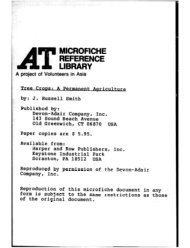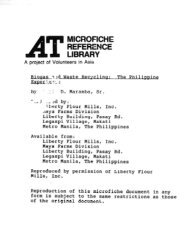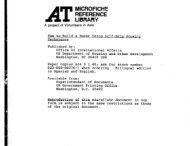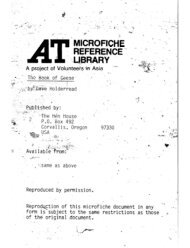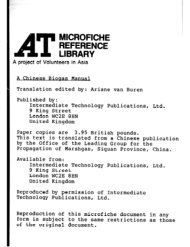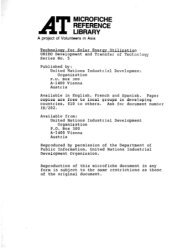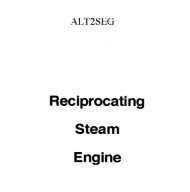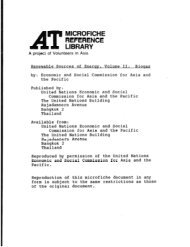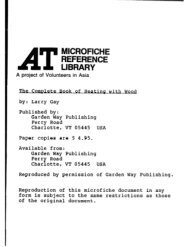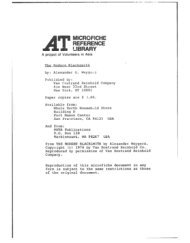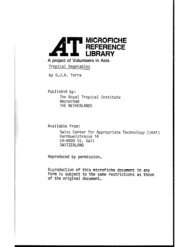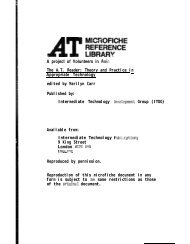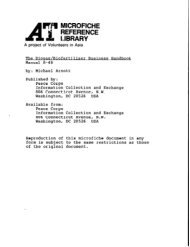Vegetation as an indicator of high wind velocity
Vegetation as an indicator of high wind velocity
Vegetation as an indicator of high wind velocity
You also want an ePaper? Increase the reach of your titles
YUMPU automatically turns print PDFs into web optimized ePapers that Google loves.
McMahon, T.A., 1975: The mechnical design <strong>of</strong> trees. Sci. Amer. 253:<br />
92-102.<br />
Discusses the mech<strong>an</strong>ical design <strong>of</strong> trees <strong>an</strong>d the relationship<br />
between height <strong>an</strong>d diameter <strong>of</strong> a tree. The diameter <strong>of</strong> the tree incre<strong>as</strong>es<br />
<strong>as</strong> the 3/2 power <strong>of</strong> tree height according to the model <strong>of</strong> el<strong>as</strong>tic<br />
similarity.<br />
Moss, A.E., 1940: Effects on trees <strong>of</strong> <strong>wind</strong> driven salt water. J. Forestry,<br />
38, 421-425.<br />
This paper describes the effect <strong>of</strong> <strong>wind</strong> driven salt on trees.<br />
Moss found injury only occurred when the tree w<strong>as</strong> exposed to the direct<br />
force <strong>of</strong> the <strong>wind</strong>.<br />
Neel, P.L. <strong>an</strong>d R.W. Harris, 1971: Motion-induced inhibition <strong>of</strong> elongation<br />
<strong>an</strong>d induction <strong>of</strong> dorm<strong>an</strong>cy in Liquidambar. Science 173(3991):<br />
58-59.<br />
Six <strong>of</strong> eight Liquidambar trunks were moderately shaken for 30<br />
seconds daily, <strong>an</strong>d they were compared CO the unshaken trees for their<br />
height growth <strong>an</strong>d terminal buds. An endogeneous mech<strong>an</strong>ism for regulating<br />
tree growth in <strong>wind</strong> situations is implicated. (Formation <strong>of</strong> reaction wood<br />
along with the other growth modificationshappenswhen the prevailing <strong>wind</strong><br />
applies <strong>an</strong>d blows from one direction for several hours or days toward<br />
the tree.)<br />
Opatowski, I., 1946: On oblique growth <strong>of</strong> trees under the action <strong>of</strong><br />
<strong>wind</strong>s. Bul. <strong>of</strong> Math. Biophys. 8: 41-49.<br />
In this article, it is shown that <strong>an</strong> inclined regular growth<br />
<strong>of</strong> tree trunks under the action <strong>of</strong> prevailing <strong>wind</strong>s may be explained <strong>as</strong><br />
a response <strong>of</strong> the pl<strong>an</strong>t to mechnical action <strong>of</strong> the <strong>wind</strong>. The mechnical<br />
effect <strong>of</strong> <strong>wind</strong>s on the trunk <strong>of</strong> trees h<strong>as</strong> subst<strong>an</strong>tially two different<br />
forms. One occurs when <strong>an</strong> unusually strong <strong>wind</strong> bends the tree into a<br />
pl<strong>as</strong>tic r<strong>an</strong>ge, so that a very large portion <strong>of</strong> the tree trunk may<br />
acquire the perm<strong>an</strong>ently abnormal position, the trunk continues to grow<br />
vertically. The other is the oblique growth <strong>of</strong> the whole tree trunk<br />
under the action <strong>of</strong> prevailing <strong>wind</strong>s. A numerical example <strong>of</strong> this second<br />
effect is developed <strong>an</strong>d results for a palm tree agree with observational<br />
data.<br />
Putnam, P.C., 1948: Power from the Wind. New York, V<strong>an</strong> Nostr<strong>an</strong>d.<br />
Trees are discussed <strong>as</strong> <strong>indicator</strong>s <strong>of</strong> <strong>wind</strong> power potential.<br />
Different types <strong>of</strong> <strong>wind</strong> deformation are discussed <strong>as</strong> well <strong>as</strong> the effect<br />
<strong>of</strong> species <strong>an</strong>d age. Conifers are described <strong>as</strong> good <strong>indicator</strong>s <strong>of</strong> <strong>wind</strong>.<br />
This is probably the earliest attempt to use trees <strong>as</strong> <strong>an</strong> <strong>indicator</strong> crf<br />
<strong>wind</strong> characteristics.<br />
- 57 -



